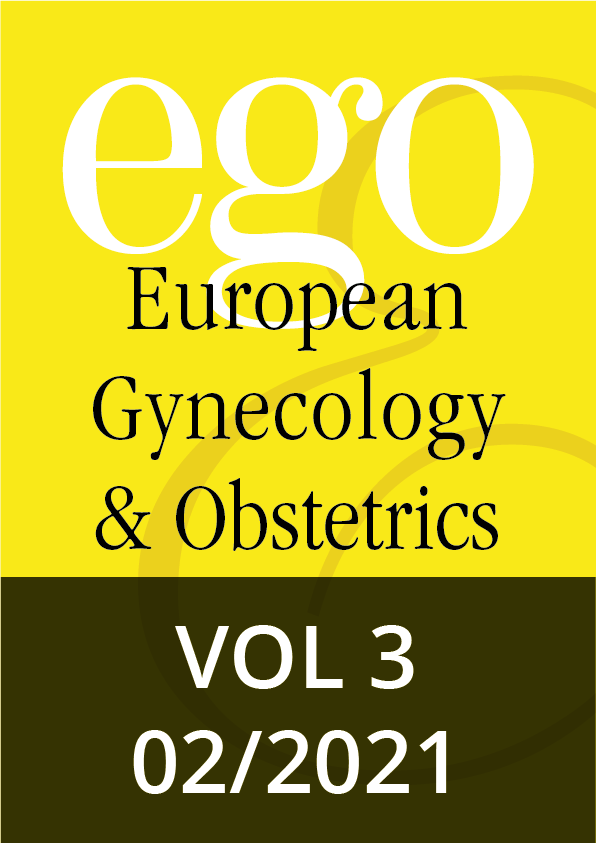Short reviews, 060–062 | DOI: 10.53260/EGO.213021
Systematic review, 063–071 | DOI: 10.53260/EGO.213022
Case reports, 072–075 | DOI: 10.53260/EGO.213023
Case reports, 076–078 | DOI: 10.53260/EGO.213024
Case reports, 079–081 | DOI: 10.53260/EGO.213025
Case reports, 082–085 | DOI: 10.53260/EGO.213026
Original articles, 086–090 | DOI: 10.53260/EGO.213027
Original articles, 091–095 | DOI: 10.53260/EGO.213028
Original articles, 096–099 | DOI: 10.53260/EGO.213029
Original articles, 100–107 | DOI: 10.53260/EGO.2130210
Original articles, 108–112 | DOI: 10.53260/EGO.2130211
“Cervical Box”: a simple way to predict spontaneous delivery at term of pregnancy
Abstract
Background and purpose: Cervical ripening is one of the most important factors involved in labor. The aim of the present study was to correlate the sonographic aspect of cervical ripening, expression of morpho-functional features and changes of cervix, with the success of spontaneous delivery.
Methods: 50 singleton pregnant women at term of their first pregnancy were enrolled and underwent to cervical assessment by transvaginal ultrasound. In all cases, cervical length was measured and the cervix has been qualitatively described as “hyperechoic” or “hypoechoic” compared to the echogenicity of fetal head bones. To quantify the echogenicity, histogram of gray scale of cervix was calculated with “ImageJ” software. Two groups were formed on the basis of the time lapse between cervical assessment and delivery: in the first one (group A), the delivery occurred within 96 hours, whereas in the second one (group B) after 96 hours. Statistical analysis has been applied for quantitative variables (mean value of echogenicity and cervical length) and qualitative variables (hyperechogenicity and hypoechogenicity).
Results: Data showed a significant higher echogenicity (p<0.05) in women who delivered within 96 hours from the examination, while no significant statistical difference has been seen in cervical length. Qualitative study of cervical echogenicity, as an indipendent predictive parameter of birth, provided a sensitivity of 78.3%, a specificity of 86.3%, a positive predictive value of 85.7% and a negative predictive value of 79.2%.
Conclusions: Cervical echogenicity might be a simple and useful parameter in clinical practice for the management of pregnancy at term.
Keywords: Cervical length, cervical ripening, induction of labor, spontaneous delivery, transvaginal ultrasound.
Citation: Luchi C.,Posar G.,Monacci F.,Arini F.,Carmignani A.,Simoncini T., “Cervical Box”: a simple way to predict spontaneous delivery at term of pregnancy, EGO European Gynecology and Obstetrics (2021); 2021/02:086–090 doi: 10.53260/EGO.213027
Published: May 1, 2021
ISSUE 2021/02

Short reviews, 060–062 | DOI: 10.53260/EGO.213021
Systematic review, 063–071 | DOI: 10.53260/EGO.213022
Case reports, 072–075 | DOI: 10.53260/EGO.213023
Case reports, 076–078 | DOI: 10.53260/EGO.213024
Case reports, 079–081 | DOI: 10.53260/EGO.213025
Case reports, 082–085 | DOI: 10.53260/EGO.213026
Original articles, 086–090 | DOI: 10.53260/EGO.213027
Original articles, 091–095 | DOI: 10.53260/EGO.213028
Original articles, 096–099 | DOI: 10.53260/EGO.213029
Original articles, 100–107 | DOI: 10.53260/EGO.2130210
Original articles, 108–112 | DOI: 10.53260/EGO.2130211
